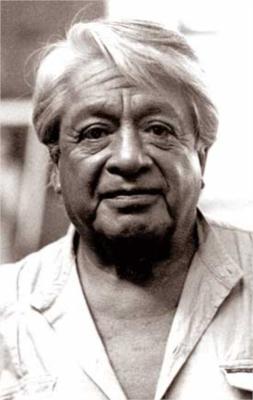Quito (Equador), 1919 – 1999
By Francisco Alambert
Painter, muralist, and sculptor, the “universal Ecuadorian whose work transcends all borders…”, in the words of Pablo Neruda, was the son of an indigenous man and a mestiza woman. He studied at the Quito School of Fine Arts between 1932 and 1940. In 1939, he participated in a group exhibition at the Ecuadorian Writers and Artists Union. His first solo exhibition was held in 1942. In the 1940s, several of his works were purchased by Nelson Rockefeller, which led him to the United States, where he exhibited in 1943 at the Museum of Art (Three South American Painters in San Francisco) and at the City Art Museum, Saint Louis (South American Artists), alongside Susana Guevara, Enrique G. Brent, and Candido Portinari. That same year, in Mexico, he studied fresco painting with José Clemente Orozco (1883-1949).
Between 1944 and 1945, Guayasamín traveled throughout South America, visiting Peru, Bolivia, Argentina, Uruguay, and Brazil. Besides exhibiting in these countries, he created a series of impactful paintings called Huacayñán, the “path of tears” in the Quechua language, which were presented at the Colonial Art Museum in Quito in 1951 and at the Museum of Fine Arts in Caracas in 1952 (and later in various cities worldwide). In 1948, he created his first fresco, El incario y la conquista, for the Ecuadorian House of Culture. In 1956, he received the Grand Prize at the III Hispanic-American Biennial of Art in Spain, Barcelona, and the following year the Grand Painting Prize at the IV São Paulo Biennial (where his works were shown again at the XX edition).
In the 1950s, he exhibited multiple times in the United States, Europe, and various Latin American countries. In 1960, he received an honorary room at the II Inter-American Biennial of Painting, Sculpture, and Engraving in Mexico, where he was also awarded. In the 1960s, he created a series of 250 paintings called La edad de la ira, which were exhibited in 1966 at the Two Worlds Gallery in Rome, at the Museum of Fine Arts of Mexico in 1968, and at the Museum of Fine Arts in Santiago, Chile, in 1969, before touring the rest of the world. In 1974, Guayasamín received the title of “Officier de L’Ordre des Arts et des Lettres” from the French government, which also awarded him the Legion of Honor in 1984.
In the 1970s, several retrospectives of his work took place in San Francisco (1974), Medellín (Colombia, 1976), Quito (1977), Saint Petersburg (Hermitage Museum), and Havana (National Museum), both in 1982. In 1994, he received a UNESCO medal for the Defense of Human Rights. His last exhibitions were held in 1995 at the Luxembourg Palace Museum in Paris and at the Palais de Glace Museum in Buenos Aires.
Shortly before his death, the artist was working on a piece called La capilla del hombre. He left several murals in various cities, such as Quito (in the Government and Legislative Palaces, the Central University, and the Provincial Council), Madrid (Barajas Airport), Paris (UNESCO headquarters), and São Paulo (Madre y niño, at the Latin American Parliament, in the Memorial of Latin America, a building designed by Oscar Niemeyer). Among his monuments stand out A la patria joven in Guayaquil (Ecuador) and A la resistencia (Rumiñahui) in Quito. He also left several portraits of politicians and intellectuals, such as Fidel Castro and Raúl Castro, François and Danielle Mitterrand, Gabriel García Márquez, Rigoberta Menchú, and the Brazilian president Juscelino Kubitschek. In 2001, the Ecuadorian House of Culture inaugurated the exhibition Tribute to Master Oswaldo Guayasamín.




